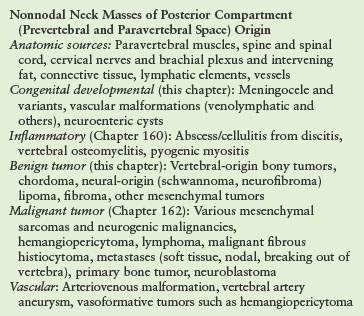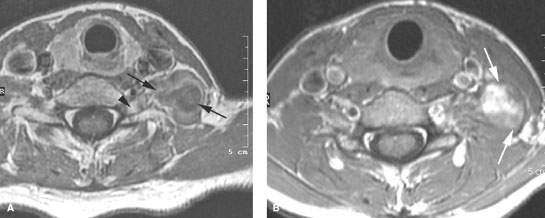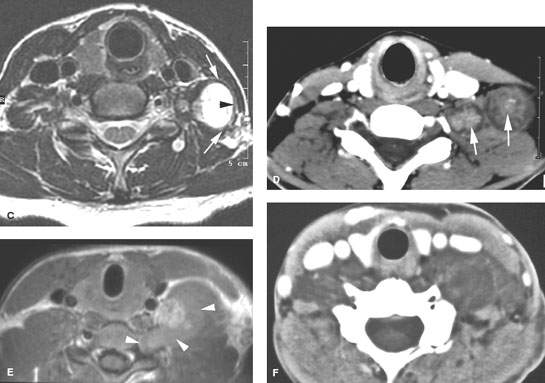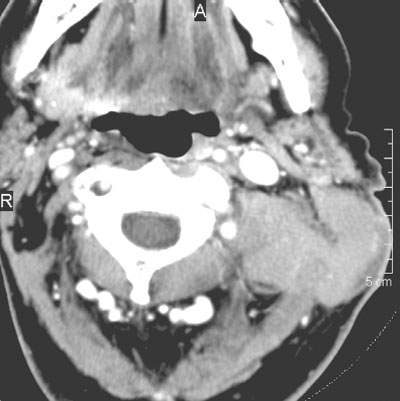POSTERIOR COMPARTMENT: BENIGN AND DEVELOPMENTAL MASSES
KEY POINTS
- Magnetic resonance imaging and computed tomography provide the critical and usually definitive data needed in the diagnosis and management of posterior compartment masses.
- Prompt and accurate imaging can help to avoid rare and potentially severe complications related to the cervical spinal cord in some posterior compartment pathology.
- Imaging-guided tissue sampling may be useful in the management of these masses.
INTRODUCTION
The posterior compartment of the neck is discussed in this chapter as the site of origin of mass lesions of the infrahyoid neck. The posterior compartment is a relatively uncommon site of origin of neck masses. This compartment is not often secondarily involved by masses that originate in the visceral compartment, retropharyngeal space, and lateral compartment, but masses of posterior compartment origin may mimic the presentation of lateral compartment disease, as discussed in Chapter 150. The spectrum of diseases that might present as a mass in the posterior compartment is outlined in Table 161.1.
Clinical Presentation
The primary presentation is usually that of a neck mass of uncertain etiology without associated signs or symptoms or other physical findings. There is often a history of progressive enlargement of the mass.
Tenderness and fever and associated generalized swelling may be present and are much more likely in the inflammatory conditions discussed in Chapter 160. Vascular malformations may be compressible and/or pulsatile, and masses may feel obviously cystic to palpation.
Neurologic dysfunction is usually due to cervical nerve root involvement but may be due to involvement of the contained phrenic nerve and nearby cervical sympathetics, vagus nerve, and recurrent laryngeal nerves. Signs of cervical spinal cord compromise may suggest that a very urgent problem is at hand.
TABLE 161.1. DIFFERENTIAL DIAGNOSTIC CONSIDERATIONS BY GENERAL ETIOLOGIES OF POSTERIOR COMPARTMENT NECK MASSES

APPLIED ANATOMY
The anatomy of the posterior compartment that directs the spread of masses in the prevertebral and paravertebral spaces is simple. The prevertebral fascia is thick and relatively resistant to the spread of pathologic processes compared to the fascia of the visceral and lateral compartments. This deep layer of the deep fascia then reflects laterally over the vertebral transverse processes and the attachments of the scalene muscles to cover the paravertebral portion of the posterior compartment of the neck, as discussed in Chapters 142 and 149 (Figs. 142.3A, 149.1, and 149.2). It is penetrated laterally by small vessels and the cervical nerve rootlets, with the most prominent of the latter being those of the brachial plexus. These fascial attachments provide a relatively resistant barrier to spread of masses between the posterior and other compartments, although masses that follow traversing nerves and vessels can track from one compartment to another (Fig. 161.1).
Structures of Interest
The analysis of a benign mass of the posterior compartment (prevertebral and paravertebral spaces) depends on a thorough understanding of its relationship to the following structures:
- Superiorly: Hyoid bone as the arbitrary boundary
- Inferiorly: Thoracic inlet, supraclavicular fossa, and posterior chest wall
- Anteriorly: Retropharyngeal space and lateral compartments
- Posteriorly: Cervical spine and pre- and paravertebral muscles and fascia and more superiorly the lower clivus if in the prevertebral space; if of paravertebral space origin, the containing fascia and subcutaneous soft tissues
- Medially: Not applicable in the prevertebral space; spinal and neurologic elements if in the paravertebral space
- Laterally: Lateral compartment (mainly the posterior triangle) of the neck/carotid sheath/brachial plexus from the trunks distally


FIGURE 161.1. Four patients with nerve sheath tumors originating in the posterior compartment of the neck. A–C: Patient 1 with magnetic resonance imaging (MRI) showing the mass extending from about the cervical root ganglion (arrowhead in B) into the lateral neck following the nerve of origin across compartments (arrows), possibly partially restricted by fascial boundaries against the tumor periphery (arrowhead in C). D: Patient 2 with contrast-enhanced computed tomography (CECT) showing the mass extending from about the cervical root ganglion (arrowhead) into the lateral neck following the nerve of origin across compartments. E: Patient 3 with MRI showing the mass extending well into the neural foramen and bulging into the lateral neck but mainly contained in the posterior compartment (arrowheads). F: Patient 4 with CECT showing plexiform neurofibromas growing both in the prevertebral and paravertebral components of the posterior compartment.
IMAGING APPROACH
Computed Tomography and Magnetic Resonance Imaging
The infrahyoid neck is mainly evaluated with computed tomography (CT) and magnetic resonance imaging (MRI). The specifics and relative value of using these studies in this anatomic region are reviewed in Chapter 149. Problem-driven protocols for CT and MRI are presented in Appendixes A and B. In general, MRI is more definitive than CT for the evaluation of posterior compartment masses both for lesion characterization and its relationship to the spinal nerve roots and cord. MRI should be done urgently or emergently if there is any hint that the cervical spinal cord might be threatened.
Other
Ultrasound has a potential triage role to play in the evaluation of a pulsatile mass but is most often cost additive and unlikely to contribute to definitive medical decision making. It may actually delay a more timely use of a likely more definitive CT or magnetic resonance (MR) study.
Catheter angiography is used selectively and most often as a prelude to endovascular intervention once the diagnosis has been established by imaging and related computed tomographic angiography or MR angiography.
PATHOPHYSIOLOGY AND PATTERNS OF DISEASE AND DIFFERENTIAL DIAGNOSIS AS SEEN ON MAGNETIC RESONANCE IMAGING AND COMPUTED TOMOGRAPHY
The initial evaluation of a potential mass in the posterior compartment is highly driven by the patient age, specific clinical situation, and related likely disease category; thus, these factors are a fundamental consideration used as part of the framework for the diagnostic process and related medical decision making.
Interpretation of imaging first should determine whether the posterior compartment is the site of origin and then whether the mass has secondarily involved the lateral or visceral compartment and related retropharyngeal space as a transspatial process. Transspatial benign masses that begin in the posterior compartment are almost always due to nerve sheath tumors (Fig. 161.1). The mechanisms and potential routes of transspatial spread vary. For locally aggressive pathologies such as the fibromatoses (Figs. 161.2–161.4), cancer or infection is a simple morphologic spread pattern to understand. It is also is a fairly intuitive pattern to understand in developmental abnormalities that affect these spaces. For instance, since venolymphatic malformations grow due to disordered vascular budding, they simply follow vessels as those vessels would normally traverse various compartments or spaces of the infrahyoid neck. Nerve sheath tumors simply follow the cervical roots of origin.
Differential Diagnosis
The method of the differential diagnosis is driven by an orderly process of relatively simple observations that may be made on the basis of magnetic resonance (MR) and/or CT studies. The process may be supplemented by imaging-directed aspiration and/or tissue sampling, which is very safe and effective in this region especially when compared to what it takes to secure a surgical sample (Chapter 6). The suggested process is as follows:
- Determine whether the process involves single or multiple compartments/spaces.
- If single, determine which space is involved. In this chapter, it would be centered mainly in the paravertebral space based on making the following observations with regard to vectors of structural displacement and spread of the mass.
- Superiorly, the process may approach the posterior skull base in the vicinity of the upper cervical spine or foramen magnum (Figs. 161.5 and 161.6).
- Inferiorly, the mass may track to the supraclavicular fossa and into the upper back (Fig. 161.3).
- Laterally, the paravertebral space is most often involved. The lateral compartment of the neck may then be secondarily involved (Figs. 161.1–161.4).
- Medially, the process will occupy the midline or a tightly paramedian position if in the prevertebral space; if in the paravertebral space, it may involve the spine and neural elements (Figs. 161.6).
- Anteriorly, the process will displace the prevertebral muscles and fascia and possibly the anterior longitudinal ligament if of prevertebral space/spinal origin (Fig. 161.1F).
- Posteriorly, the process will involve the paravertebral space, spinal elements, and epidural space if in the prevertebral space (Figs. 161.1E and 161.6); if in the paravertebral space, it will expand the containing fascia toward the subcutaneous fat and skin (Figs. 161.4 and 161.6).
- Superiorly, the process may approach the posterior skull base in the vicinity of the upper cervical spine or foramen magnum (Figs. 161.5 and 161.6).
- Observations regarding the morphology of the mass may require both MRI and CT (Figs. 161.4, 161.7, and 161.8).
- Identify associated findings such as those relating to spinal elements and epidural involvement (Figs. 161.5 and 161.6).

FIGURE 161.2. An adult presenting with a posterior neck mass. Contrast-enhanced computed tomography shows the mildly enhancing mass to involve the sternocleidomastoid muscle and deeper paraspinous musculature and emphasizing the often transcompartmental spread of the fibromatoses.
Stay updated, free articles. Join our Telegram channel

Full access? Get Clinical Tree








